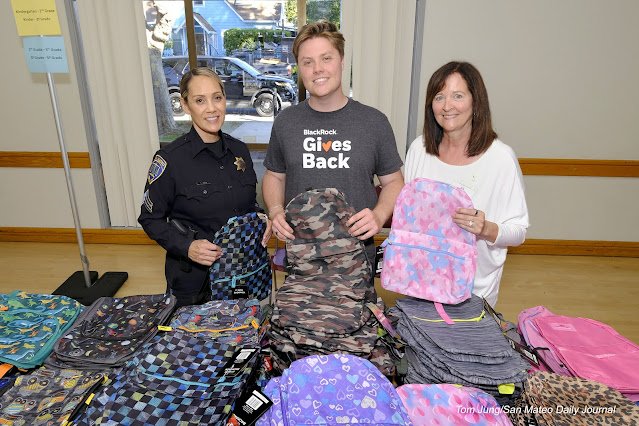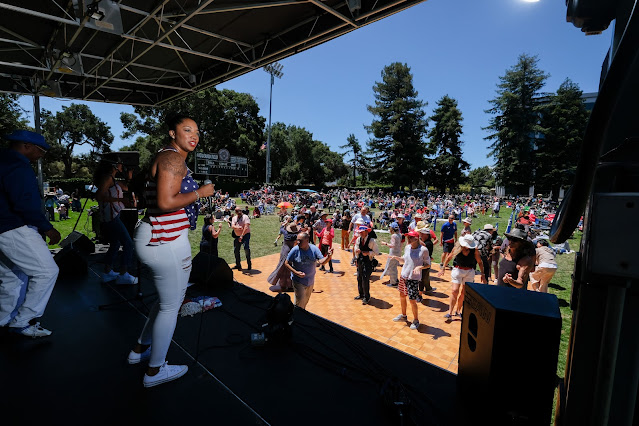The assignment was to make a photo of Redwood City native Mike Annuzzi as a promotion for his upcoming show at the Fox Theater. I've been very fortunate that my assignments have included so many local talents, I was delighted with the prospect of photographing another San Mateo County creative.
My editor suggested that a photograph could be published to highlight Mr. Annuzzi's first theater performance in Redwood City, his home town. While casting about for the background location, Mr. Annuzzi suggested that a local music store in RWC might be appropriate and convenient. He sent me a photo of the store's guitar showroom, and I liked what I saw. After confirming that a 1:00 pm photoshoot would present little or no hardship on the store's operations, we went for it.
When I first saw the showroom, I decided to concentrate on the following visual elements:- I wanted to use converging lines to direct the viewer's attention to Mr. Annuzi's face,
- I wanted to feature as many guitars as possible, and
- I wanted the lighting placement to add some visual drama.
I started with a shoot-through umbrella mounted on top of a light stand at a height of almost eight feet. This test shot demonstrated that I would need to increase the output to get the desired level of brightness. Also, I would be shooting from the back of the store towards the front, and the store itself was pretty dark when compared to the showroom.
For this next shot, I added two flashes that are positioned out of frame. First, I put a snoot on Flash Number two and positioned it outside the showroom and pointed directly as Mr. Annuzzi's head. If you look closely you can see the highlight on his neck which provides some background separation. Flash Number Three was pointed at the guitar display just outside of the showroom.For this shot I positioned the camera very close to the ground with the intent of using the black ceiling to direct the viewer towards Ms. Annuzzi's face. Looking at the intersection of the black ceiling and my subject's head, I think I overdid it. Time to move on.
 For the final series of shots I added two additional flashes. First, I wasn't happy with the black ceiling visible at the front of the store. I added Flash Number Four on the counter and aimed it towards the ceiling. Fortunately it naturally pointed to the light fixture in the ceiling. This suggests, gently, that the lighting fixture itself provided that bit of brightness. Flash Number Five was clamped to a stool and pointed straight down at the floor. This bounce light provides a bit of fill light that is barely detectable because it does not add additional highlights on the subject's face.
For the final series of shots I added two additional flashes. First, I wasn't happy with the black ceiling visible at the front of the store. I added Flash Number Four on the counter and aimed it towards the ceiling. Fortunately it naturally pointed to the light fixture in the ceiling. This suggests, gently, that the lighting fixture itself provided that bit of brightness. Flash Number Five was clamped to a stool and pointed straight down at the floor. This bounce light provides a bit of fill light that is barely detectable because it does not add additional highlights on the subject's face.
Looking back, it might seem that this was a lot of work for a photo as ephemeral as a newspaper publicity shot. However, I wasn't looking for a simple shot. I wanted a photo that had some visual depth, where one could sense that there were details behind the main subject, and I believe the photo succeeded. I was not without some areas that could be improved.
Light Spillage: I struggled to eliminate, or at least reduce, the glare coming off the faces of these guitars. My first impulse was to change the position of the key light in relation to my shooting position. After several tries, I gave it. But during post production, I realized the glare was not created by the light's location, It was actually light spilling over the edge of the shoot-through umbrella. I then noticed that the shadows from the "shiny" guitars were cast in a direction different from those from the guitars closer to the ceiling. What I should have done was to add some sort of light-proof barrier (called a "flag") on the flash head to prevent the light from sneaking past the umbrella. A big piece of gaffer tape would have done the trick, so I just slapped a 2" wide strip of gaffer tape onto the flash body so I won't have to look for one the next time it's needed. Be sure to fold one end over itself (sticky face to sticky face) to provide a handy tab for rapid deployment.Kicking The Kicker: The "kicker" light is directed from behind the subject and used to provide separation from the background.In this uncropped version of the submitted photo you can see the kicker at left edge of frame. The arrows along Mr. Annuzzi's right side shows where the light "skidded" off the edge to provide a rim of light. Since the flash hadn't yet been restricted by a grid spot or a snoot, its broad beam light edges his whole upper body. When a snoot or grid spot is added, the beam would be narrower, and lighting a specific portion of the subject would become a matter of luck.
The work-around for this would be to position your subject and then walk back to where the flash is. With the grid spot/snoot in place, photograph your subject from the rear. When you preview the image, you can see exactly how much of the subject will benefit from the kicker. Adjust the light until the beam falls exactly where you want it.
Now that I have solutions to these "in the field" problems, I can wait for another assignment that requires a similar level of attention to detail. Incidentally, the shoot took about one hour from first to last handshake, but the satisfaction I received from the final result was immeasurable.

















